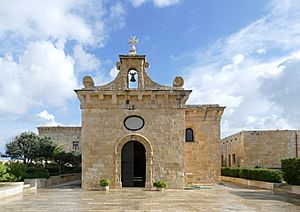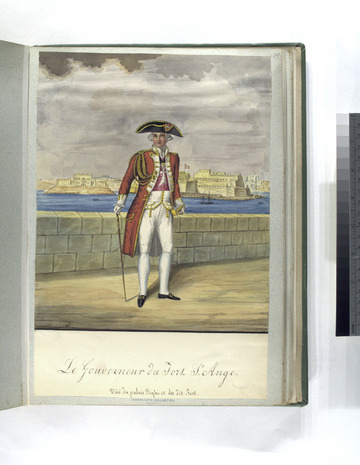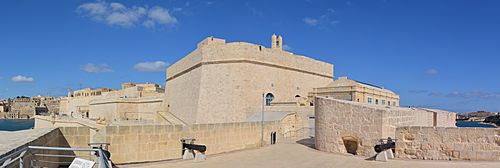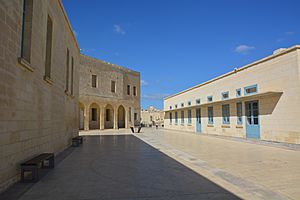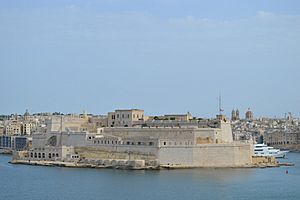Fort St. Angelo facts for kids
Quick facts for kids Fort St. Angelo |
|
|---|---|
| Forti Sant'Anġlu | |
| Part of the fortifications of Birgu | |
| Birgu, Malta | |
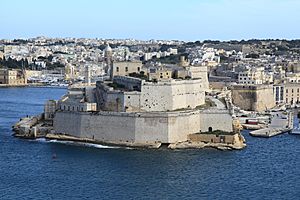
Fort St. Angelo as seen from the Upper Barrakka Gardens
|
|
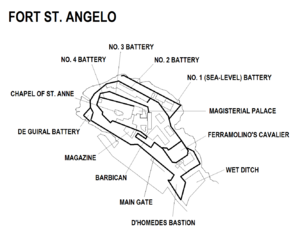
Map of Fort St. Angelo
|
|
| Coordinates | 35°53′31″N 14°31′6″E / 35.89194°N 14.51833°E |
| Type | Bastioned fort; previously a castle |
| Area | 13,000 m2 (140,000 sq ft) |
| Site information | |
| Owner | Government of Malta |
| Controlled by | Cottonera Waterfront Group Heritage Malta Sovereign Military Order of Malta |
| Open to the public |
Most of fort, partially on occasions |
| Condition | Intact |
| Site history | |
| Built | c. 13th century–1691 |
| Built by | Order of Saint John |
| In use | c. 13th century–1979 |
| Materials | Limestone |
| Battles/wars | Battle of Malta Attack of 1551 Great Siege of Malta Siege of Malta (1798–1800) Siege of Malta (World War II) |
| Garrison information | |
| Garrison | 450 |
Fort St. Angelo is a strong fort located in Birgu, Malta. It sits right in the middle of the Grand Harbour. This famous fort was first built a long time ago, in the Middle Ages. Back then, it was a castle known as the Castrum Maris, which means "Castle by the Sea".
Later, the Order of Saint John arrived in Malta. They rebuilt the castle into a powerful fort between the 1530s and 1560s. Fort St. Angelo is most famous for being the Knights' main base during the Great Siege of Malta in 1565. This was a huge battle where the Knights defended Malta against a large invasion. In the 1690s, the fort was rebuilt again, giving it the look it has today.
The British military used the fort from 1800 until 1979. During this time, it was sometimes called HMS Egmont or HMS St Angelo. The fort was badly damaged during World War II, but it has since been fixed up. In 1998, the top part of the fort was given to the Sovereign Military Order of Malta. Fort St. Angelo is also considered a possible UNESCO World Heritage Site.
Contents
History
Early Times and Ancient History
People have lived at the site of Fort St. Angelo for a very long time. Even before recorded history, there was a special place of worship there. Ancient people built a temple to the goddess Astarte on this spot.
We don't know exactly when the first fort was built. But old remains show it was a fortified place. Large stone blocks and a pink granite column can still be seen inside the fort's chapel. It's thought that Arabs might have developed the site around 870 AD. However, there is no clear proof of this. An old church carved into the rock was also nearby. It existed since around 600 A.D.
The Middle Ages
The fort likely started as a real fortification in the Middle Ages. Around 1220, Emperor Frederick II appointed his own governors for Malta. These governors needed a safe place to live and protect the crown's interests. Parts of a tower from the 12th century can still be seen today.
The first time the fort was called Castrum Maris (Castle by the Sea) was in the 1240s. Documents from that time mention it. Later, during a short period of French rule (1266–83), the castle was again called Castrum Maris. It had 150 soldiers and many weapons. By 1274, the castle already had two chapels, which are still there. From 1283, the Maltese islands were ruled by Aragon. The fort was used by governors who protected the Aragonese crown.
The Knights' Period
When the Order of Saint John arrived in Malta in 1530, they chose to live in Birgu. They saw that Fort St. Angelo was partly empty and damaged. After fixing it up, it became the home of the Grand Master. This included repairing the governor's house and the Chapel of St. Anne.
The Knights made Fort St. Angelo their main stronghold. They made it much stronger and changed its design. They dug a dry ditch to make a moat and built the D'Homedes Bastion by 1536. By 1547, a large cavalier (a raised platform for guns) was built. The De Guirial Battery was also added to protect the harbor entrance. These changes turned the fort into a powerful place for cannons.
Fort St. Angelo bravely faced the Turks during the Great Siege of Malta in 1565. It even stopped a sea attack on the nearby town of Senglea. After the siege, the Knights built the new city of Valletta. They moved their main offices there.
In the 1690s, the fort was repaired again. Much of what the fort looks like today comes from these repairs. They were designed by Carlos de Grunenbergh. He also paid for four new gun batteries facing the Grand Harbour. You can still see his family crest above the fort's main gate. When the French arrived in 1798, the fort was very strong. It had about 80 cannons. During the two years of French rule, the fort was the French Army's headquarters.
The British Period
When the British came to Malta, the fort remained an important military base. At first, the Army used it as a wireless station. In 1800, two battalions of soldiers lived there. Later, in the early 1900s, the Navy took over the fort. It became a naval base for the Royal Navy in the Mediterranean. In 1912, it was called HMS Egmont. In 1933, its name changed to HMS St Angelo.
The British did not change the fort much. They did convert one battery for large nine-inch guns in the 1860s. They also built a cinema and a water plant in the early 20th century.
During World War II, the fort was attacked many times. It had three Bofors anti-aircraft guns. The fort was hit 69 times between 1940 and 1943. In 1979, the Royal Navy left Malta. The fort was given to the Maltese government. Parts of it fell into disrepair after a plan to turn it into a hotel failed in the 1980s.
Recent History
On December 5, 1998, a special agreement was signed. It gave the upper part of Fort St. Angelo to the Sovereign Military Order of Malta. This part includes the Grand Master's House and the Chapel of St. Anne. The agreement allows both the Maltese flag and the Order's flag to fly over the fort.
Other parts of the fort are rented to a private group. In 2012, a large amount of money was given to restore the fort. This money came from a European fund. The restoration was managed by Heritage Malta. It was finished in September 2015. Now, the fort is a major place for visitors. It also hosts important national events.
Layout
When the Knights arrived in 1530, the Castrum Maris was a castle with many buildings inside. These included the governor's house and the Chapel of St. Mary. The castle also had another chapel dedicated to St. Angelo.
By the time of the Great Siege of Malta in 1565, the fort still looked mostly medieval. But the Knights had made some changes:
- D'Homedes Bastion – This was built during the time of Grand Master Juan de Homedes. It was changed a lot over the years. Part of it was destroyed in World War II but was fixed later.
- Ferramolino's Cavalier – This was a tall platform for cannons near D'Homedes Bastion. It was built between 1542 and 1547. It had openings for eight cannons.
- De Guiral Battery – This was a small cannon battery right by the sea on the fort's western side. It was named after its commander during the Great Siege.
Most of the fort's current shape comes from the rebuilding in the 1690s. Grunenbergh added four batteries facing the Grand Harbour entrance. Batteries No. 1, No. 2, and No. 4 were changed by the British. Battery No. 3 still looks much like it did originally.
Gallery
See also
 In Spanish: Fuerte de San Ángel para niños
In Spanish: Fuerte de San Ángel para niños


